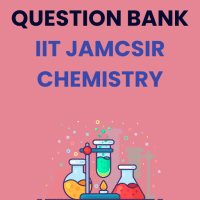Chemistry Exam > Chemistry Questions > A gas cylinder containing cooking gas can wit...
Start Learning for Free
A gas cylinder containing cooking gas can withstand a pressure of 15 atm. The pressure gauge of cylinder indicate 10 atm. at 27°C. Due to sudden fire in the building, its temperature starts rising. At what temperature the cylinder will explode?
Correct answer is '450'. Can you explain this answer?
Most Upvoted Answer
A gas cylinder containing cooking gas can withstand a pressure of 15 a...
°C. What is the actual pressure of the gas in the cylinder?
We can use the ideal gas law to solve this problem:
PV = nRT
where P is the pressure, V is the volume, n is the number of moles of gas, R is the gas constant, and T is the temperature in Kelvin.
First, we need to convert the temperature from Celsius to Kelvin:
T = 27 + 273.15 = 300.15 K
Next, we can rearrange the ideal gas law to solve for the actual pressure of the gas:
P = nRT/V
We know that the cylinder can withstand a pressure of 15 atm, and the pressure gauge indicates 10 atm. This means that the difference between the actual pressure and the gauge pressure is:
ΔP = 15 atm - 10 atm = 5 atm
So the actual pressure is:
P = 10 atm + 5 atm = 15 atm
Now we can use the ideal gas law to find the number of moles of gas:
n = PV/RT
We know the pressure, volume, and temperature, but we need to convert the volume from liters to cubic meters:
V = 0.01 m³
Putting in the values, we get:
n = (15 atm)(0.01 m³)/(0.0821 L·atm/mol·K)(300.15 K) = 0.00606 mol
Therefore, the actual pressure of the gas in the cylinder is 15 atm, and there are 0.00606 moles of gas in the cylinder.
We can use the ideal gas law to solve this problem:
PV = nRT
where P is the pressure, V is the volume, n is the number of moles of gas, R is the gas constant, and T is the temperature in Kelvin.
First, we need to convert the temperature from Celsius to Kelvin:
T = 27 + 273.15 = 300.15 K
Next, we can rearrange the ideal gas law to solve for the actual pressure of the gas:
P = nRT/V
We know that the cylinder can withstand a pressure of 15 atm, and the pressure gauge indicates 10 atm. This means that the difference between the actual pressure and the gauge pressure is:
ΔP = 15 atm - 10 atm = 5 atm
So the actual pressure is:
P = 10 atm + 5 atm = 15 atm
Now we can use the ideal gas law to find the number of moles of gas:
n = PV/RT
We know the pressure, volume, and temperature, but we need to convert the volume from liters to cubic meters:
V = 0.01 m³
Putting in the values, we get:
n = (15 atm)(0.01 m³)/(0.0821 L·atm/mol·K)(300.15 K) = 0.00606 mol
Therefore, the actual pressure of the gas in the cylinder is 15 atm, and there are 0.00606 moles of gas in the cylinder.
Free Test
FREE
| Start Free Test |
Community Answer
A gas cylinder containing cooking gas can withstand a pressure of 15 a...
Pv = nRT... here volume of cylinder is constant ...so p = kT ..or, P1/T1 = P2/T2. . or, 10/300=15/T2...or T2 = 450

|
Explore Courses for Chemistry exam
|

|
Question Description
A gas cylinder containing cooking gas can withstand a pressure of 15 atm. The pressure gauge of cylinder indicate 10 atm. at 27°C. Due to sudden fire in the building, its temperature starts rising. At what temperature the cylinder will explode?Correct answer is '450'. Can you explain this answer? for Chemistry 2025 is part of Chemistry preparation. The Question and answers have been prepared according to the Chemistry exam syllabus. Information about A gas cylinder containing cooking gas can withstand a pressure of 15 atm. The pressure gauge of cylinder indicate 10 atm. at 27°C. Due to sudden fire in the building, its temperature starts rising. At what temperature the cylinder will explode?Correct answer is '450'. Can you explain this answer? covers all topics & solutions for Chemistry 2025 Exam. Find important definitions, questions, meanings, examples, exercises and tests below for A gas cylinder containing cooking gas can withstand a pressure of 15 atm. The pressure gauge of cylinder indicate 10 atm. at 27°C. Due to sudden fire in the building, its temperature starts rising. At what temperature the cylinder will explode?Correct answer is '450'. Can you explain this answer?.
A gas cylinder containing cooking gas can withstand a pressure of 15 atm. The pressure gauge of cylinder indicate 10 atm. at 27°C. Due to sudden fire in the building, its temperature starts rising. At what temperature the cylinder will explode?Correct answer is '450'. Can you explain this answer? for Chemistry 2025 is part of Chemistry preparation. The Question and answers have been prepared according to the Chemistry exam syllabus. Information about A gas cylinder containing cooking gas can withstand a pressure of 15 atm. The pressure gauge of cylinder indicate 10 atm. at 27°C. Due to sudden fire in the building, its temperature starts rising. At what temperature the cylinder will explode?Correct answer is '450'. Can you explain this answer? covers all topics & solutions for Chemistry 2025 Exam. Find important definitions, questions, meanings, examples, exercises and tests below for A gas cylinder containing cooking gas can withstand a pressure of 15 atm. The pressure gauge of cylinder indicate 10 atm. at 27°C. Due to sudden fire in the building, its temperature starts rising. At what temperature the cylinder will explode?Correct answer is '450'. Can you explain this answer?.
Solutions for A gas cylinder containing cooking gas can withstand a pressure of 15 atm. The pressure gauge of cylinder indicate 10 atm. at 27°C. Due to sudden fire in the building, its temperature starts rising. At what temperature the cylinder will explode?Correct answer is '450'. Can you explain this answer? in English & in Hindi are available as part of our courses for Chemistry.
Download more important topics, notes, lectures and mock test series for Chemistry Exam by signing up for free.
Here you can find the meaning of A gas cylinder containing cooking gas can withstand a pressure of 15 atm. The pressure gauge of cylinder indicate 10 atm. at 27°C. Due to sudden fire in the building, its temperature starts rising. At what temperature the cylinder will explode?Correct answer is '450'. Can you explain this answer? defined & explained in the simplest way possible. Besides giving the explanation of
A gas cylinder containing cooking gas can withstand a pressure of 15 atm. The pressure gauge of cylinder indicate 10 atm. at 27°C. Due to sudden fire in the building, its temperature starts rising. At what temperature the cylinder will explode?Correct answer is '450'. Can you explain this answer?, a detailed solution for A gas cylinder containing cooking gas can withstand a pressure of 15 atm. The pressure gauge of cylinder indicate 10 atm. at 27°C. Due to sudden fire in the building, its temperature starts rising. At what temperature the cylinder will explode?Correct answer is '450'. Can you explain this answer? has been provided alongside types of A gas cylinder containing cooking gas can withstand a pressure of 15 atm. The pressure gauge of cylinder indicate 10 atm. at 27°C. Due to sudden fire in the building, its temperature starts rising. At what temperature the cylinder will explode?Correct answer is '450'. Can you explain this answer? theory, EduRev gives you an
ample number of questions to practice A gas cylinder containing cooking gas can withstand a pressure of 15 atm. The pressure gauge of cylinder indicate 10 atm. at 27°C. Due to sudden fire in the building, its temperature starts rising. At what temperature the cylinder will explode?Correct answer is '450'. Can you explain this answer? tests, examples and also practice Chemistry tests.

|
Explore Courses for Chemistry exam
|

|
Signup for Free!
Signup to see your scores go up within 7 days! Learn & Practice with 1000+ FREE Notes, Videos & Tests.























